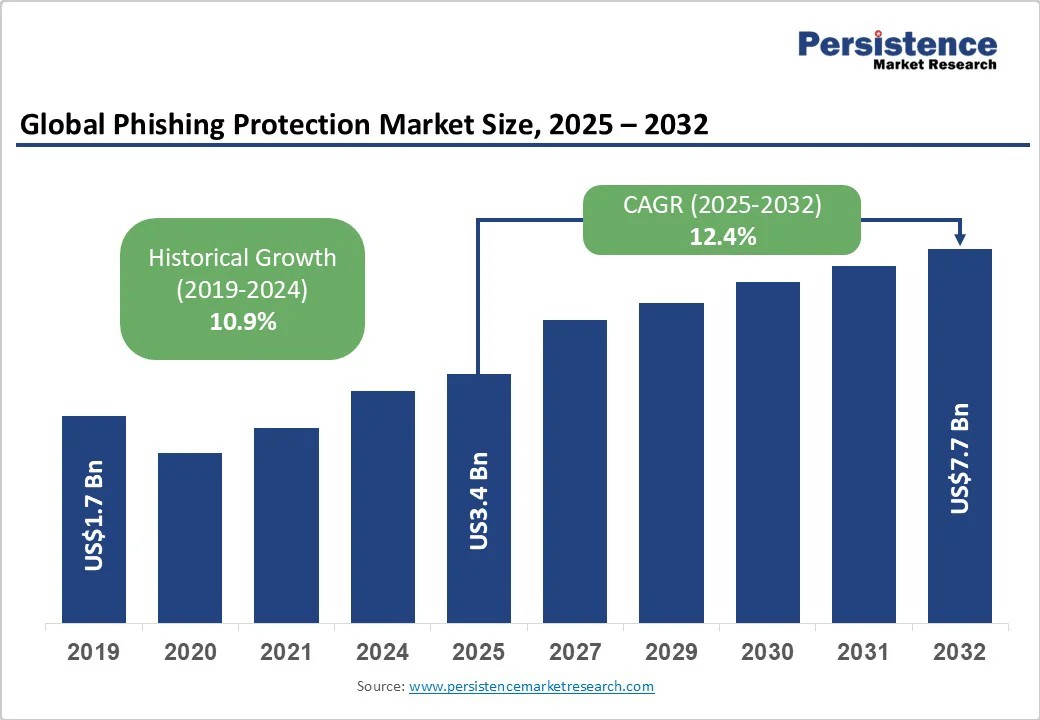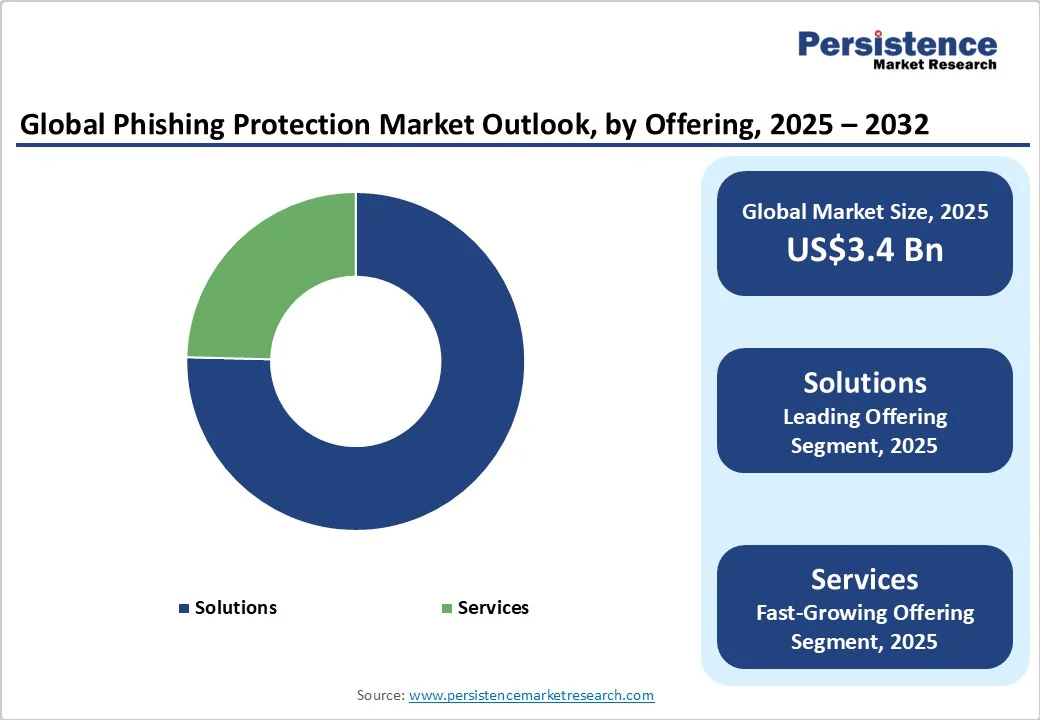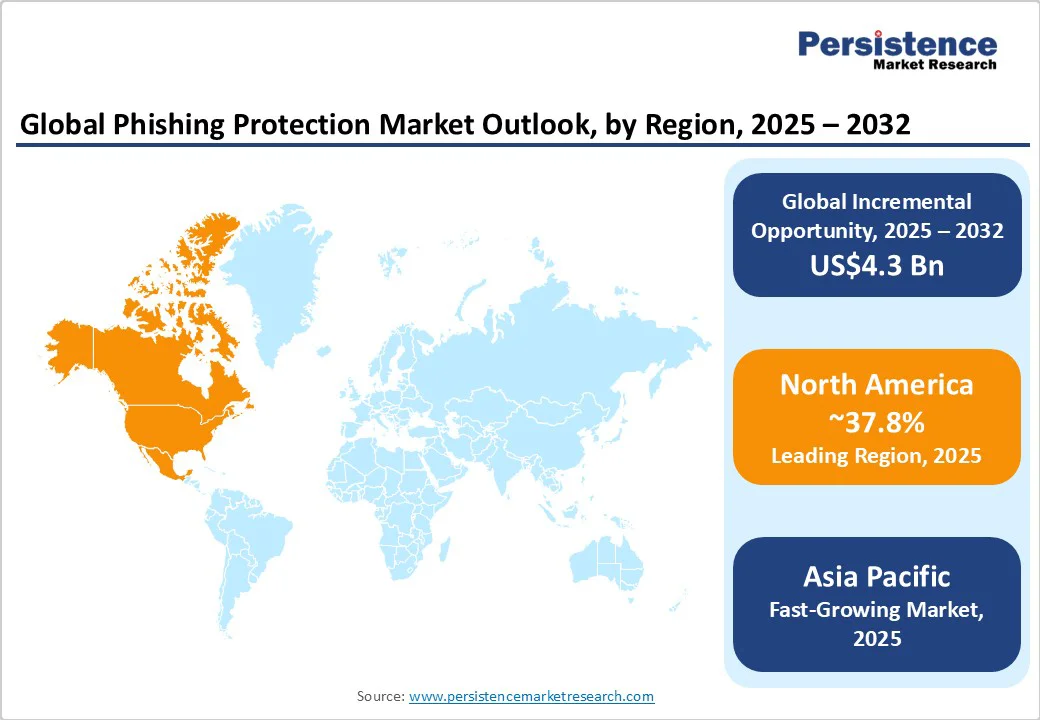ID: PMRREP35727| 180 Pages | 14 Oct 2025 | Format: PDF, Excel, PPT* | IT and Telecommunication

The global phishing protection market size is expected to be valued at US$3.4 billion in 2025. It is projected to reach US$7.7 billion by 2032, growing at a CAGR of 12.4% during the forecast period of 2025 -2032, driven by increasingly sophisticated cyber threats that exploit human behavior and digital vulnerabilities. The adoption of cloud-based communication platforms is another key driver.
| Key Insights | Details |
|---|---|
| Phishing Protection Market Size (2025E) | US$3.4 Bn |
| Market Value Forecast (2032F) | US$7.7 Bn |
| Projected Growth (CAGR 2025 to 2032) | 12.4% |
| Historical Market Growth (CAGR 2019 to 2024) | 10.9% |

A key growth driver is the rising focus on proactive rather than reactive phishing defense. Organizations are shifting from merely responding to attacks to anticipating and neutralizing them before they cause damage. This includes continuous threat intelligence monitoring, automated phishing simulations, and employee awareness programs tailored to emerging attack vectors.
For instance, Boxphish’s security awareness training combines simulated phishing exercises with dark web monitoring to identify potential vulnerabilities in real time. By emphasizing proactive strategies, enterprises can reduce human error while strengthening their security posture. This shift toward preemptive measures is fueling the demand for integrated phishing protection solutions that combine technology, training, and continuous monitoring.
Another major growth driver is the smooth integration of AI-based threat detection into cloud email and collaboration platforms. As organizations rely on cloud solutions such as Microsoft 365, Google Workspace, and Slack, embedding intelligent security tools directly into these environments allows real-time identification of phishing attempts.
AI systems analyze email content, sender reputation, and behavioral patterns to detect anomalies before they reach the user. For example, Microsoft’s Defender for Office 365 now employs AI to flag potentially harmful links and attachments across Teams, SharePoint, and Outlook, preventing attacks that bypass traditional filters.
One significant barrier to effective phishing protection is the potential for security systems to flag genuine communications as malicious incorrectly. Overly aggressive detection algorithms can disrupt business operations by blocking important emails, notifications, or transactions.
For instance, AI-based filters may misidentify legitimate financial alerts or client correspondence as phishing attempts, causing delays and operational inefficiencies. Companies in highly regulated sectors, such as banking or healthcare, are primarily cautious because inadvertently blocking important messages can compromise compliance and erode customer trust.
Phishing protection is often constrained by the inherent difficulty of addressing social engineering tactics that manipulate human behavior. Attackers typically craft highly personalized messages using AI and open-source intelligence, making it challenging for automated systems to detect deception.
Employees may be deceived by realistic emails that appear to come from executives or trusted partners, bypassing technical safeguards. In 2025, over 80% of successful security breaches in enterprises involved some form of human manipulation rather than system vulnerabilities. Hence, regardless of how advanced the technology, training and awareness programs remain essential.
A key growth opportunity lies in the adoption of novel visual and behavioral analysis technologies. Modern attacks increasingly exploit subtle cues in emails, websites, and messaging platforms, which traditional filters often miss.
By utilizing AI-based visual recognition and behavioral profiling, security systems can identify anomalies such as unusual sender behavior, deceptive URLs, and the imitation of trusted interfaces. For example, Cofense and SlashNext are employing machine learning to analyze email layouts and user interactions, enabling real-time detection of sophisticated phishing attempts.
Another promising growth avenue is the development of end-to-end phishing resistance strategies that combine technology, policy, and user awareness. Instead of relying solely on detection tools, organizations can integrate multi-layered security frameworks that include secure email gateways, DNS filtering, employee training, and incident response automation.
Microsoft’s integration of AI-backed phishing alerts with Microsoft 365 Defender illustrates this holistic approach, delivering coordinated protection across email, cloud applications, and collaboration tools. End-to-end resistance strategies not only mitigate immediate threats but also strengthen the organization’s security posture, enabling quick detection, containment, and recovery from attacks.
Solutions are anticipated to account for approximately 75.4% of the market share in 2025, owing to the increasing sophistication of cyberattacks and the limitations of traditional security measures. Attackers now employ novel techniques such as AI-generated phishing emails, which are highly personalized and contextually relevant, making them difficult to distinguish from legitimate communications. The widespread use of HTTPS by phishing sites also adds another layer of complexity, as users may mistakenly perceive these sites as trustworthy.
Services are expected to experience steady growth through 2032, driven by the increasing complexity of phishing attacks and the need for specialized expertise to counter them. Organizations are recognizing that traditional security measures are insufficient against modern phishing tactics, prompting a shift toward managed services that deliver continuous monitoring, threat intelligence, and incident response capabilities. For instance, TD Synnex's partnership with Boxphish to provide security awareness training across the U.K. and Ireland highlights the industry's move toward comprehensive services.
The on-premises segment is poised to hold a share of nearly 65.3% in 2025 as it is preferred by organizations that prioritize control over their security infrastructure. This approach enables personalized configurations, ensures stringent data residency, and ensures compliance with local regulations. For instance, financial institutions often opt for on-premises solutions to meet specific audit and regulatory requirements.
Cloud-based phishing protection solutions are experiencing rapid growth due to their cost-effectiveness and ease of deployment. Organizations can quickly expand their security measures to match the dynamic nature of cyber threats without significant upfront investments. The integration of artificial intelligence and machine learning in cloud solutions improves real-time threat detection and response capabilities.
BFSI is likely to register a share of about 34.7% in 2025, as it is a primary target for phishing attacks due to the high value of the financial data and transactions it handles. Cybercriminals exploit vulnerabilities in this sector to gain unauthorized access to sensitive information, leading to significant financial losses and reputational damage. For instance, in 2024, the global average cost of a data breach rose to US$4.88 million, with the financial sector being particularly susceptible due to its vast digital footprint and valuable data assets.
Cybercriminals increasingly target retail and e-commerce platforms due to their direct consumer interactions and high transaction volumes. Phishing attacks in this sector often involve impersonation of brands to harvest customer credentials and payment information. In 2024 alone, 3.7 billion malicious URLs were detected, with a significant portion targeting retail and e-commerce businesses.

In 2025, North America is expected to account for approximately 37.8% of the market share, driven by the increasing sophistication of cyber threats and the region's pivotal role in global digital activity. In the first quarter of 2025, North America accounted for 38% of global phishing email volume, highlighting its prominence as a target for cybercriminals.
The surge in phishing attacks has prompted organizations to adopt unique security measures, including AI-based detection systems and multi-layered defense strategies, to safeguard sensitive information and maintain trust with consumers.
The increasing prevalence of AI-backed phishing attacks is a key concern in North America. Cybercriminals are utilizing generative AI to craft highly convincing phishing emails and websites that closely mimic legitimate entities, resulting in minimal errors and making them challenging to detect. This development emphasizes the demand for continuous innovation in phishing protection solutions to counteract evolving threats effectively.
Phishing attacks in Asia Pacific have surged drastically, with incidents increasing by 220% compared to pre-pandemic levels. This surge is attributed to the ongoing digital transformation and the proliferation of mobile and online services, which have expanded the attack surface for cybercriminals. Hence, organizations are adopting novel phishing protection solutions, including multi-layered security protocols, to safeguard sensitive information and maintain consumer trust.
A notable example is the collaboration between the Australian Securities and Investments Commission (ASIC) and other Asia-Pacific regulators to combat the region's US$2.7 billion in losses from scams. This initiative highlights the collective effort to improve phishing protection measures and mitigate the financial impact of such attacks. The rise of AI-powered phishing attacks has further introduced new challenges in threat detection.
Phishing remains the leading entry point for cyberattacks in Europe, accounting for 60% of incidents, according to ENISA's 2025 Threat Landscape report. This prevalence highlights the urgent need for robust phishing protection measures across the region. A key concern is the increasing sophistication of phishing attacks, mainly those using artificial intelligence. By early 2025, AI-supported phishing campaigns represented over 80% of observed social engineering activities worldwide.
These AI-driven attacks are often challenging to detect and require novel fall detection systems to mitigate effectively. The financial sector remains a primary target for phishing attacks, with a notable increase in Business Email Compromise (BEC) scams.
These scams often involve impersonation of executives or trusted entities to deceive employees into transferring funds or sensitive information. The increasing complexity of these attacks necessitates the development of improved security protocols and user awareness training to prevent breaches.

The global phishing protection market is characterized by ongoing technological developments and surging sophistication in cyber threats. Leading tech firms are improving their platforms with superior anti-phishing features.
Microsoft, for example, has taken proactive steps by disabling the display of inline SVG images in Outlook, a format frequently exploited in phishing attacks. The market is also witnessing a surge in specialized training solutions aimed at reducing human error, a key factor in successful phishing attacks.
The phishing protection market is projected to reach US$3.4 Billion in 2025.
Rising AI-driven attacks and increasing emphasis on proactive defense are the key market drivers.
The phishing protection market is poised to witness a CAGR of 12.4% from 2025 to 2032.
Integration of AI with cloud platforms and security awareness training are the key market opportunities.
Abnormal Security, Cofense, and Barracuda Networks are a few key market players.
| Report Attribute | Details |
|---|---|
| Historical Data/Actuals | 2019 - 2024 |
| Forecast Period | 2025 - 2032 |
| Market Analysis | Value: US$ Bn |
| Geographical Coverage |
|
| Segmental Coverage |
|
| Competitive Analysis |
|
| Report Highlights |
|
By Offering
By Deployment Mode
By Sub-type
By End Use
By Region
Delivery Timelines
For more information on this report and its delivery timelines please get in touch with our sales team.
About Author